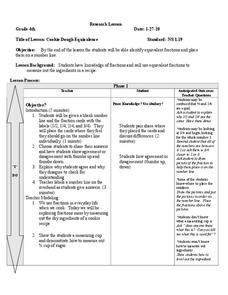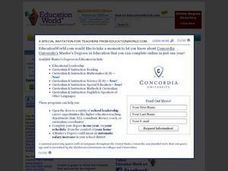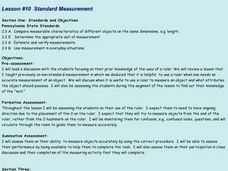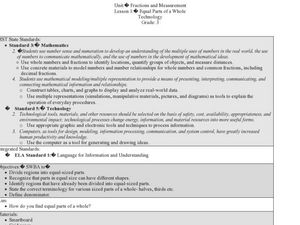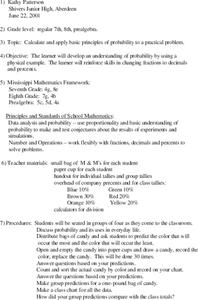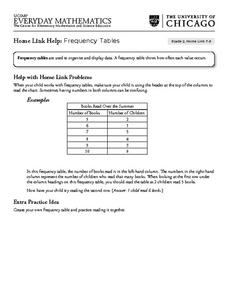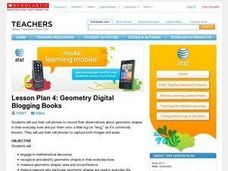Learn NC
Peanut Butter and Jelly and Order of Operations
Study order of operations using a peanut butter and jelly sandwich activity as your guide. The class watches you make a peanut butter and jelly sandwich based on a volunteer's instructions. They discuss the importance of following...
Curated OER
Fractions
Fourth graders use pattern blocks and fraction identification cards to create and identify fractions. In this fractions lesson plan, 4th graders identify fractions in a pizza, and make fractions with markers.
Curated OER
Cookie Dough Equivalence
Who doesn't love cookies? For this lesson, learners follow a recipe to make cookies, practicing their ability to compare fractions as they go. This is a wonderful way to motivate your class to practice this important skill.
Curated OER
Decimal Bingo
Practice converting decimals into fractions. They draw a 3x3 grid and write in any nine common fractions with denominator 10 or 100 and with numerators 9 or less. The group listens as the teacher call out decimal numbers within the given...
Curated OER
Paper Folding to Make Cubes
Examine patterns of figures composed of six-squares and predict which of the twenty presented could be folded to make a cube. They then fold large-scale patterns of these figures to confirm their hunches.
Curated OER
Holiday Greeting Cards: A Graphing Activity
Pupils examine statistics about the popular type of greeting cards and create pie or bar chart using an online tool. They illustrate the sales statistics for the greeting cards before making the charts.
Curated OER
Lesson #10 Standard Measurement
Learners are introduced to units of measurement found on a ruler as well as what attributes make an object difficult or easier to measure with a ruler. The teacher has various objects placed around the room, and the youngsters practice...
Curated OER
Concept Attainment Model: Volume and Surface Area
Using a concept attainment approach, learners identify surface area and volume by sorting examples (photos) that depict each concept (positive) from those that don't (negative). Then as a class, they develop definitions of each...
Curated OER
Maps and Modes, Finding a Mean Home on the Range
Fifth graders investigate data from maps to solve problems. In this data lesson, 5th graders study maps and collect data from each map. Students present their data in a variety of ways and calculate the mode, mean, median, and range.
Curated OER
Making an Angle Eater
Third graders create angle eaters where they use circles with cut outs to identify right, obtuse, and acute angles. Students complete 1 angle eater.
Curated OER
Usage and Interpretation of Graphs
Cooperative groups are formed for this graphing activity. Each group must construct a graph that represents how many eyelets (the holes for laces in shoes), are present in their group. A whole-class bar graph is eventually constructed...
Curated OER
Fractions and Measurement
Using a Smart Board, or a plain ol' white board or chalkboard, the teacher pulls up a grid and demonstrates how squares and rectangles can be divided up into equal parts. The class will get their own graph paper to draw shapes and divide...
Curated OER
So Many Cats!
First graders listen to the book, So Many Cats, and discuss the number of cats in the story. They demonstrate simple addition problems using cat counters and a work mat in the shape of a house.
Curated OER
Probability using M & M's
Using M & M's candies, young statisticians predict the color distribution in a packet of candies and test their predictions against their group and the larger class. A review of converting between fractions, decimals, and percents...
Curated OER
What's in a Shape?
Students explore characteristics of shapes by making and using tangram sets. They discover how the tangram pieces are related to one another, and determine how many different combinations of the triangles, squares, and parallelograms in...
Curated OER
Frequency Tables - Home Link Support
In this home school support worksheet, 2nd graders, with a home support person, review the use of frequency tables to organize and display data. They make their own frequency table and read it with the support person.
Curated OER
The Shape of Things
As young learners listen to the story The Shape of Things, by Dayle Ann Dodds, they see how shapes can be found all around us. On a provided worksheet, scholars choose a shape, then make it into a picture. They add details, and...
Curated OER
Translate Word Phrases and Sentences into Equations
Use this video to show your learners an example of how to translate word phrases into an equation to solve a real-world problem. The presenter begins with a review of how to use cross products to solve a proportion, including how to do...
Curated OER
Shapes are Everywhere
Second graders gain an understanding of geometric shapes and spatial reasoning. They learn the attributes of solid shapes in everyday activities. Students compare geometric shapes to everday objects, finding things that serve a purpose...
Curated OER
Environmental Graphing
Students experiment with graphing. In this graphing introduction lesson, students complete four activities: 1) a bar graph based on class birthdays 2) an estimation graph of the raisins in raisin bread 3) another estimation example with...
Curated OER
Ovals, Rectangles, Squares, and Triangles
Students identify geometrical shapes displayed in photographs of everyday objects in a metropolitan setting.
Curated OER
How Much Water Do We Use In Our Homes?
Students discover the amount of water used for everyday activities around their home in this lesson plan. They research the amount of water needed by accessing a provided internet link. They then graph the information they discovered and...
Curated OER
Geometry Digital Blogging Books
Students observe geometric shapes in their everyday lives. In this middle school/high school mathematics instructional activity, students use their cell phone to record and publish their observations about the geometric shapes they...
Curated OER
Treasure Hunt for Shapes
Students identify shapes in objects of everyday items. They are looking for circles, squares, triangles and rectangles. They draw each shape on a piece of paper and write the name of the shape underneath it to keep for future reference.


